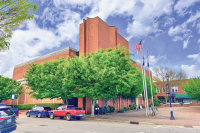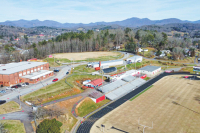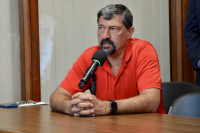Uncovering the past before it’s too late: Old Smokies’ homesites slowly succumbing to time and elements
 As Don Casada veered off-trail and began bushwhacking his way over fallen logs and through overgrown shrubs along the shore of Lake Fontana, he barely glanced at the trusty GPS unit in his hand.
As Don Casada veered off-trail and began bushwhacking his way over fallen logs and through overgrown shrubs along the shore of Lake Fontana, he barely glanced at the trusty GPS unit in his hand.
He’d been this way before, many times, and knew just where he was going. Casada finally stopped at a clearing marked by a looming stone chimney, all that is left of a cabin that early Appalachian settlers had once called home.
The reliable chimney once spewed smoke and radiated heat for the family that lived inside, now long gone. Casada approached the chimney and touched one of its stones, as if to remind himself it was real. He recalled that it was several feet shorter than when he first stumbled up upon it several years ago, with pieces of the chimney breaking off and falling to the ground around it as the clay and mortar deteriorate with time.
“History will fade; chimneys will fall; time will cover bottles; and metal will erode.” Casada said of the looming historic relic and others like it found inside the Great Smoky Mountains National Park.
Casada is an artifact and home site hunter, who scours forgotten trails of Smokies with a GPS system in search of artifacts and physical clues of the inhabitants who lived on the land before it became part of the park and they were forced to leave.
He works alongside fellow amateur historian and Swain County resident Wendy Meyers. Her task is to hunt down the stories and oral histories of the people who once accompanied the artifacts for which Casada endlessly searches.
Related Items
Together, their mission is to not only to record as much of the oft-forgotten human history of the park before the layers of time cover and degrade it even more but also give it credence.
Between the 1920s and 1940s, to make way for one of the largest conservation projects in American history — the half-million-acre Great Smoky Mountains National Park — thousands of residents of Western North Carolina were forced to leave their farms, churches, schools, barns and homes. Some families had hardly departed from their land when park officials torched their former houses and possessions in an attempt to erase the traces of humankind from the new park.
But it was impossible for the park to entirely erase their history. There still remain the memories, the stories, or as the case may be for so many early Appalachian settlers within the park’s borders, an artifact: a chimney, a rosebush, a whiskey bottle or an old rock wall or carriage road — now overgrown with bushes and weeds
And for park visitors who are fortunate enough to stumble upon a human clue, for those who take care to look and don’t entirely believe the myth of the Wild East — that the land taken for the park was as inhabited jungle — will notice, on a trail, in a thicket, when something seems slightly out of place, crafted by the hand of man, rather than nature.
However, what might not seem like a pressing task for Casada and Meyers — retracing routes of stagnant history — actually has a sense of urgency for the two historians.
Especially for Meyers, who relies on personal accounts to collect information for their research, the urgency is a little more human.
“If we don’t act now, a lot of the sources will have dried up,” Meyers said. “As time goes by people are dying.”
Already, the youngest profile of a person who can contribute first-hand information to the project is in their late 70s. People who may remember the earlier history of the park are already in their 90s.
But Meyer’s challenge isn’t only a race against time, it’s one against distance too.
Settlers who lost their homes and land to make way for the newly-created national park were paid for their loss by the government, but they were forced to start over elsewhere and couldn’t always afford a new farm with what they’d been paid. Many moved to other parts of the Southeast to work in the textile factories or to the northwest to log timber.
Meyers uses census records, family trees, government surveys, deeds, personal contacts, obituaries, the phone book, the internet and many more tools to find an important source who can maybe tip Casada off to a unknown building, whose foundation is obscured and hard to find within the park boundaries, or identify the former inhabitants of a structure the two have already found.
It’s slow work. Meyers can spend a whole day making phone calls and doing research just to track down one photograph or someone who may have a link to the past. She has interviewed more than 50 people for the project, and sometimes she’ll turn up an interviewee with a sharp memory who can help the team record where each person in a long-since disappeared community lived.
Yet tracking down someone who has a direct connection to the history of the pre-park settlers doesn’t always guarantee a fruitful interview.
“One man, who was 8 years old at the time of the first taking, said all he remembered was his dad raised hogs and it was the end of the world when they had to leave,” Meyers said.
Other interview subjects Meyers tracks down may have Alzheimer’s disease or dementia.
And sometimes, even when the pair comes away with what they think is a reliable account of where certain buildings were in the park and who lived in them, they later come to find that the memories were as faded as the forgotten building’s foundations. Once Casada reviewed five different accounts of where a school and a church were once located on Indian Creek. Each person recalled them being in a different location. Only one of the interviewees was correct, and Casada was able to locate the school.
“The old man was dead on,” Casada said about the location of the school.
However, he continues his hunt for the church.
Casada uses a hand-held GPS unit to log all the home sites he’s visited and notes whether he successfully found traces of a structure or not. Sometimes he has to return multiple times before he stumbles across the foundation of an old shed or cellar. When the park took the land, all the buildings were burned to the ground.
To help with his field work, Casada uses a collection of old topographic maps dating back to before the park’s creation that denote structures with a black box, but sometimes the markers are not accurate or remnants of the structure have become too shrouded in time.
“There is a lot of wandering through the woods looking for evidence,” Casada said.
His work has brought him along all 800 miles of the park’s trails, which is more like 2,000 actual miles walked if you account for all the back-tracking of following a trail to its end and then turning around. And those figures don’t include the countless miles of scrambling up ridgelines, trekking along old wagon roads or bushwhacking up streambeds. Many settlements were concentrated near a water source.
One of the problems is Casada doesn’t always know what he’s looking for. Sometimes the signs are discreet as flowers or shrubs that would have been planted around someone’s house decades ago — like periwinkles, daffodils, or a rose bush — which otherwise wouldn’t be found growing deep in the woods. Another tell-tale sign: a grouping of walnut trees, popular back then for their nuts, natural dyes and other uses.
Many of the home sites close to trails or the road have been picked over by park visitors who illegally pilfer found artifacts, but sometimes it’s an old hinge or a rusting washtub that tips Casada off and is a sure sign of a human past.
In other instances, Casada said, he has found himself inspecting a pile of rocks to determine if it’s a collapsed chimney, or in fact just a pile of rocks.
Only estimates exist when it comes to how many old homes are out there in the Great Smoky Mountains Park wilderness. In Swain County — the county with most land invested in the park and where the team focuses its work — Casada has few facts to go off.
In Swain County, during the first acquisition of land for the park, 180 tracts of land from private individuals were purchased. Because of shoddy record keeping, however, Casada doesn’t know exactly how may houses were on those properties. He estimates it could be around 250.
And later, about 450 houses were on lands taken by the Tennessee Valley Authority in Swain County, about half of which were on properties handed over to the Park Service and half of which were flooded by the lake.
Casada uses a rough multiplier of six people per household to calculate the displacement of people in Swain County during those several decades. Places like Cataloochee Valley in Haywood County and many parts of Tennessee also had large populations of people who had to pick up and leave their homes.
But, it wasn’t just houses, it was cemeteries; memories, heritage and way of life the people left behind. Meyers and Casada hope that by documenting their histories, the old settlers will be allowed to live on inside the park, if only by forcing those who visit and cherish it to acknowledge what was sacrificed to make it possible. The team records all their interviews and keeps digital records of their research, with the hope to publish volumes about the conflicted past of the Great Smoky Mountains National Park.
“The fact that we have a park here is a fantastically wonderful thing,” Casada said. “But people who lived here for generations have lost a lot in the making of this park.”
The land taken for the park
In 1920s and 1930s, the N.C. Park Commission purchased 200 tracts of land in Swain County, comprising 169,000 acres for the formation of the Great Smoky Mountain National Park. In terms of acreage, 89 percent was used for commercial practices such as logging and mining; the remainder belonged to individual owners. Estimates peg the number of houses at 250.
In the 1940s, the Tennessee Valley Authority added another 50,000 acres to the park, 56 percent of which was corporate or speculator-owned, with the remainder belonging to individuals. Conservative estimates place the number of houses taken at 450, about half of which are now underwater and the rest sitting on land added to the park boundaries.









